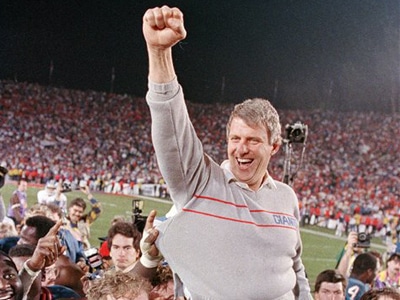Courtesy of Inc.com.
In football, when a new leader gets hired, it’s usually because his predecessor wasn’t successful. Here’s what Hall of Fame coach Bill Parcells has learned about entering a losing situation, and turning it around.
How can one new leader enter a losing culture and turn it around?
The question cuts to the heart of leadership itself, since it presumes one person can change or elevate the work ethics and personalities of countless incumbent employees–employees whose habits were likely formed amid the acceptance of losing.
Though drawing parallels between change-management principles in the sports world and those in conventional business cultures can be tricky (given all the differences in the settings), leaders can still glean valuable lessons by selectively dissecting what’s worked for coaches who’ve entered losing cultures–and emerged as decorated winners only a few years later.
In recent football history, no leader has posted a better track record of changing a culture than Hall of Fame coach Bill Parcells. His legacy includes two Super Bowl victories and one Super Bowl loss. Beyond that, he reversed a cycle of losing in five different organizations. In Parcells: A Football Life, the new authorized biography of Parcells by former Sports Illustrated writer Nunyo Demasio, you’ll find some secrets to Parcells’s success–many of which are applicable to traditional businesses, too. Here are eight of them:
1. Seek input and buy-in from incumbent employees. In 1975, when Parcells was a first-year defensive coordinator at Texas Tech, the team finished with a disappointing record of 6-5. This was in large part because the incumbent players bristled at Parcells’s hard-driving New York persona, to say nothing of his linebacker-centric schemes.
So in the offseason, Parcells held one-on-one meetings with several of the players. He sought their input on his schemes. He even–on rare occasions–allowed seniors to skip drills at practice.
2. Find a way to bond outside of the workplace. For Parcells, this place was the basketball court. He routinely played pickup basketball with his Texas Tech football players. Interacting in a low-pressure sports environment allowed the players to see their coach as a teammate and competitor, rather than as a bossy martinet from the northeast.
Sure enough, Texas Tech improved to 10-1 in 1976, ending the season ranked 13th in the nation.
3. Share your broad philosophies–and detail how they’ll help incumbent employees. In 1981, when Parcells was in his first year as defensive coordinator of the NFL’s New York Giants, he faced another culture-change challenge. This time, he was tasked with revamping a Giants defense that, the previous season, had allowed 26.5 points per game (the second-worst in the NFL).
Despite its poor performance as an overall unit, the Giants defense boasted three legitimate starting linebackers–NFL veterans who’d now have to learn Parcells’s new scheme.
So Parcells continued his habit of using one-on-one meetings to seek buy-in and reinforce lessons. This time, since he had NFL egos to massage, he made sure to stress why he thought a scheme change could help both the team and the player.
In detailing the changes, he emphasized how the players’ individual strengths factored into his reasoning. “His inclusive approach,” writes Demasio, “helped minimize resistance while promoting an understanding of his logic.”
4. Find your sergeants. One of the incumbent linebackers who needed to change how he played was six-year veteran Harry Carson. A decorated star in his own right, Carson now had to rein in his game to fit Parcells’s scheme. Thus Carson’s buy-in was essential. His cooperation would undoubtedly compel the other veterans–lesser stars with easier adjustments–to buy in as well.
So in winning over Carson, Parcells used flattery, honesty, and a pledge of talent development. He told Carson: “I think you’ve got an awful lot of talent, you’ve got good instincts, and you’re very visible out there. But I’m not sure you’re a good linebacker.”
Carson’s response to Parcells’s message was what all generals want to hear from their sergeants: “You just tell me where to start.”
5. Stay patient as employees acclimate to the changes. Even an elite talent like Carson struggled at first to adopt all of Parcells’s suggestions. After all, Carson had to unlearn more than a decade’s worth of linebacker instincts, honed in high school, college, and the NFL.
Specifically, Parcells wanted Carson to play five yards back from the line of scrimmage; Carson had played about three yards back his entire career. Carson tended to engage offensive linemen as soon as possible, a bad habit that sometimes led to his being out of position or compromised in his blocking technique.
It took a while for Carson to get used to playing farther back from the action, and showing some patience before engaging. “But Parcells kept reassuring Carson that he possessed the quickness to start farther back before the snap,” Demasio writes.
6. Deploy personnel in terms of their competence to perform key tasks, rather than in terms of their job titles. In Parcells’s scheme, the position of nose tackle was essential. In Parcells’s view, rookie Bill Neill had the skill set to do the job well. There was one problem: The Giants had drafted Neill in the fifth round to play defensive end, a different position.
All of which meant that Parcells, as a new employee, would have to butt heads with the Giants personnel department. Most of the staff were invested not only in Neill’s potential as a defensive end (as opposed to as a nose tackle), but also in their own standing as longtime Giants talent evaluators who needed to stand their ground against the new hotshot defensive coordinator.
7. Recognize when you need to be political, and when you can simply take action. When it came to the decision about how to deploy Neill, Parcells knew he had the support of Giants head coach Ray Perkins. He also knew he’d been hired by Perkins with a strong mandate: To fix the team’s execrable defense.
All of which gave him leverage when it was time to confront the personnel department–including general manager George Young–on his plans to move Neill to nose tackle. Still, Parcells was keen about playing the game. He feigned deference to the personnel experts and acknowledged his own status as the new guy. Demasio writes:
Parcells listened to the skeptics for a few more minutes, hiding his disgust that no solutions were being offered. After everyone had said his piece, Parcells calmly told the gathering that he understood that it was his first Giants training camp, and he meant no disrespect. Then Parcells added in a forceful tone: “Unless any of you guys got a better idea, I’m going to move the sonofabitch there tomorrow.”
8. Set boundaries with your bad-behaving high performers–and let them stray, every now and then, if the straying gets results. In 1981, the Giants drafted linebacker Lawrence Taylor with the second overall pick, despite already boasting a bevy of solid linebackers like Carson. Taylor’s off-the-charts talents made the decision a no-brainer.
Like many young all-world talents, Taylor had a penchant for partying hard–yet still showing up for work and dominating his tasks. Early on, Parcells told him: “Lookit, I’m going to say what’s on my mind, Lawrence. I won’t bullshit you. So don’t try to bullshit me.”
Taylor nodded in agreement. Their relationship faced an early test in the Giants’ sixth game of the season. With a 2-3 record, the home game was vital to Perkins and Parcells’s turnaround effort. On two occasions in the first half, Taylor directly disobeyed Parcells’s play calls.
Specifically, Parcells had called plays requiring Taylor to drop back into pass coverage. But on both occasions, Taylor disregarded the play call and rushed the quarterback. And on both occasions, Taylor’s approach was successful: He sacked the quarterback and forced a fumble, which the Giants recovered. In fact, the second fumble led directly to a touchdown by the Giants defense.
The crowd roared. Parcells approached Taylor and stared silently. Taylor slapped his temple with an open palm. “I did it again, didn’t I?” he said, brilliantly and brazenly acknowledging his double acts of defiance.
Parcells tried to sound stern. “You know, Lawrence, we don’t even have what you just did. It isn’t in our playbook.” Taylor replied: “Well, Coach, we’d better put it in on Monday, because it’s a dandy.”
The Giants finished the 1981 season with a 9-7 record, making the playoffs for the first time since 1963. The defense allowed only 257 total points, or 16.1 per game–a drastic improvement from the 26.5 per game the previous year.
In 1983, after Perkins left the Giants to coach at his alma mater, the University of Alabama, Parcells became the head coach. Just three seasons later, Parcells led the Giants to their first Super Bowl victory. It was the culmination of his first successful culture change at the NFL level. It established the template for a coaching legacy that would span four more teams and two more Super Bowl appearances.







